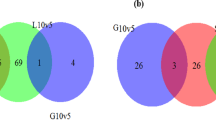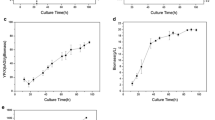Abstract
Understanding global changes of physiological processes at the molecular level during the growth of Streptococcus thermophilus is essential for the rational design of cultivation media and the optimization of bioprocesses. Transcriptomics and proteomics were combined to investigate the global changes at the transcript and protein level during the growth of S. thermophilus. The expression of 1396 genes (FDR ≤ 0.001) and 876 proteins (P < 0.05) changed significantly over time. The most remarkable growth phase dependent changes occurred in the late-lag phase and were related to heterofermentation, glycolysis, peptidoglycan biosynthesis, conversion between amino acids and stress response. The present results could provide theoretical guidance for high-cell-density culture, help design cultivation media, and help attain a high biomass of S. thermophilus.
Similar content being viewed by others
References
Bove, C.G., Angelis, M.D., Gatti, M., Calasso, M., Neviani, E., and Gobbetti, M. 2012. Metabolic and proteomic adaptation of Lactobacillus rhamnosus strains during growth under cheese-like environmental conditions compared to de Man, Rogosa, and Sharpe medium. Proteomics 12, 3206–3218.
Calderini, E., Celebioglu, H.U., Villarroel, J., Jacobsen, S., Svensson, B., and Pessione, E. 2017. Comparative proteomics of oxidative stress response of Lactobacillus acidophilus NCFM reveals effects on DNA repair and cysteine de novo synthesis. Proteomics 17, 1600178.
Cotter, P.D. and Hill, C. 2003. Surviving the acid test: responses of Gram-positive bacteria to low pH. Microbiol. Mol. Biol. Rev. 67, 429–453.
Diez, L., Solopova, A., Fernándezpérez, R., González, M., Tenorio, C., Kuipers, O.P., and RuizLarrea, F. 2017. Transcriptome analysis shows activation of the arginine deiminase pathway in Lactococcus lactis as a response to ethanol stress. Int. J. Food Microbiol. 257, 41.
Du, L., He, Y., and Luo, Y. 2008. Crystal structure and enantiomer selection by D-alanyl carrier protein ligase DltA from Bacillus cereus. Biochemistry 47, 11473–11480.
Duche, O., Tremoulet, F., Namane, A., and Labadie, J. 2002. A proteomic analysis of the salt stress response of Listeria monocytogenes. FEMS Microbiol. Lett. 215, 183–188.
Heim, S., Lleo, M.D.M., Bonato, B., Guzman, C.A., and Canepari, P. 2002. The viable but nonculturable state and starvation are different stress responses of Enterococcus faecalis, as determined by proteome analysis. J. Bacteriol. 184, 6739–6745.
Kamei, Y., Tamada, Y., Nakayama, Y., Fukusaki, E., and Mukai, Y. 2014. Changes in transcription and metabolism during the early stage of replicative cellular senescence in budding yeast. J. Biol. Chem. 289, 32081–32093.
Kang, X., Ling, N., Sun, G., Zhou, Q., Zhang, L., and Sheng, Q. 2012. Complete genome sequence of Streptococcus thermophilus strain MN-ZLW-002. J. Bacteriol. 194, 4428–4429.
Klimina, K.M., Kjasova, D.K., Poluektova, E.U., Krügel, H., Leuschner, Y., Saluz, H.P., and Danilenko, V.N. 2013. Identification and characterization of toxin-antitoxin systems in strains of Lactobacillus rhamnosus isolated from humans. Anaerobe 22, 82–89.
Koistinen, K.M., Plumed- Ferrer, C., Lehesranta, S.J., Karenlampi, S.O., and Wright, A.V. 2007. Comparison of growth-phase-dependent cytosolic proteomes of two Lactobacillus plantarum strains used in food and feed fermentations. FEMS Microbiol. Lett. 273, 12–21.
Krugel, H., Klimina, K.M., Mrotzek, G., Tretyakov, A., Schofl, G., Saluz, H.P., Brantl, S., Poluektova, E.U., and Danilenko, V.N. 2015. Expression of the toxin-antitoxin genes yefM Lrh. yoeB Lrh in human Lactobacillus rhamnosus isolates. J. Basic Microbiol. 55, 982–991.
Lahtvee, P.J., Adamberg, K., Arike, L., Nahku, R., Aller, K., and Vilu, R. 2011. Multi-omics approach to study the growth efficiency and amino acid metabolism in Lactococcus lactis at various specific growth rates. Microb. Cell Fact. 10, 1–12.
Letort, C. and Juillard, V. 2010. Development of a minimal chemically- defined medium for the exponential growth of Streptococcus thermophilus. J. Appl. Microbiol. 91, 1023–1029.
Lin, M.H., Sugiyama, N., and Ishihama, Y. 2015. Systematic profiling of the bacterial phosphoproteome reveals bacterium-specific features of phosphorylation. Sci. Signal. 8, rs10.
Liu, G., Qiao, Y., Zhang, Y., Leng, C., Sun, J., Chen, H., Zhang, Y., Li, A., and Feng, Z. 2018. Profiles of Streptococcus thermophilus MNZLW-002 nutrient requirements in controlled pH batch fermentations. Microbiologyopen 8, e00633.
Louesdon, S., Charlot-Rougé, S., Juillard, V., Tourdot-Maréchal, R., and Beal, C. 2014. Osmotic stress affects the stability of freezedried Lactobacillus buchneri R1102 as a result of intracellular betaine accumulation and membrane characteristics. J. Appl. Microbiol. 117, 196–207.
Pfaffl, M.W. 2001. A new mathematical model for relative quantification in real-time RT-PCR. Nucleic Acids Res. 29, e45.
Pfaffl, M.W., Horgan. G.W., and Dempfle, L. 2002. Relative expression software tool (REST) for group-wise comparison and statistical analysis of relative expression results in real-time PCR. Nucleic Acids Res. 30, e36.
Prajapati, J.B., Nathani, N.M., Patel, A.K., Senan, S., and Joshi, C.G. 2013. Genomic analysis of dairy starter culture Streptococcus thermophilus MTCC 5461. J. Microbiol. Biotechnol. 23, 459–466.
Qiu, W., Zheng, X., Wei, Y., Zhou, X., Zhang, K., Wang, S., Cheng, L., Li, Y., Ren, B., Xu, X., et al. 2016. D-Alanine metabolism is essential for growth and biofilm formation of Streptococcus mutans. Mol. Oral Microbiol. 31, 435–444.
Reed, M.C., Nijhout, H.F., Sparks, R., and Ulrich, C.M. 2004. A mathematical model of the methionine cycle. J. Theor. Biol. 226, 33–43.
Rolfe, M.D., Rice, C.J., Lucchini, S., Pin, C., Thompson, A., Cameron, A.D., Alston, M., Stringer, M.F., Betts, R.P., Baranyi, J., et al. 2012. Lag phase is a distinct growth phase that prepares bacteria for exponential growth and involves transient metal accumulation. J. Bacteriol. 194, 686–701.
Rossi, C.C., de Oliveira, L.L., de Carvalho Rodrigues, D., Urmenyi, T.P., Laport, M.S., and Giambiagidemarval, M. 2017. Expression of the stress-response regulators CtsR and HrcA in the uropathogen Staphylococcus saprophyticus during heat shock. Antonie van Leeuwenhoek 110, 1105–1111.
Schaffer, S., Takahashi, K., and Azuma, J. 2000. Role of osmoregulation in the actions of taurine. Amino Acids 19, 527–546.
Sheehan, V.M., Sleator, R.D., Fitzgerald, G.F., and Hill, C. 2006. Heterologous expression of BetL, a betaine uptake system, enhances the stress tolerance of Lactobacillus salivarius UCC118. Appl. Environ. Microbiol. 72, 2170.
Siragusa, S., De Angelis, M., Calasso, M., Campanella, D., Minervini, F., Di Cagno, R., and Gobbetti, M. 2013. Fermentation and proteome profiles of Lactobacillus plantarum strains during growth under food-like conditions. J. Proteomics 96, 366–380.
Soufi, B., Gnad, F., Jensen, P.R., Petranovic, D., Mann, M., Mijakovic, I., and Macek, B. 2010. The Ser/Thr/Tyr phosphoproteome of Lactococcus lactis IL1403 reveals multiply phosphorylated proteins. Proteomics 8, 3486–3493.
Wang, H. and Cronan, J.E. 2004. Functional replacement of the FabA and FabB proteins of Escherichia coli fatty acid synthesis by Enterococcus faecalis FabZ and FabF homologues. J. Biol. Chem. 279, 34489–34495.
Wang, J., Wu, R., Zhang, W., Sun, Z., Zhao, W., and Zhang, H. 2013. Proteomic comparison of the probiotic bacterium Lactobacillus casei Zhang cultivated in milk and soy milk. J. Dairy Sci. 96, 5603–5624.
Weidenmaier, C. and Peschel, A. 2008. Teichoic acids and related cell-wall glycopolymers in Gram-positive physiology and host interactions. Nat. Rev. Microbiol. 6, 276–287.
Wu, C., Zhang, J., Wang, M., Du, G., and Chen, J. 2012. Lactobacillus casei combats acid stress by maintaining cell membrane functionality. J. Ind. Microbiol. Biotechnol. 39, 1031–1039.
Zaunmuller, T., Eichert, M., Richter, H., and Unden, G. 2006. Variations in the energy metabolism of biotechnologically relevant heterofermentative lactic acid bacteria during growth on sugars and organic acids. Appl. Microbiol. Biotechnol. 72, 421–429.
Zhang, S., Scott, J.M., and Haldenwang, W.G. 2001. Loss of ribosomal protein L11 blocks stress activation of the Bacillus subtilis transcription factor ςB. J. Bacteriol. 183, 2316–2321.
Acknowledgements
This work was supported by grants from the National Natural Science Foundation of China (31771989), Natural Science Foundation of Heilongjiang Province (C2016023), and Academic Backbone Project of Northeast Agricultural University (15XG21).
Author information
Authors and Affiliations
Corresponding author
Additional information
Conflict of Interest
The authors declare that they have no conflict of interest.
Supplemental material for this article may be found at http://www.springerlink.com/content/120956.
Electronic supplementary material
Supplementary data Table S3. List of translation differences in proteins.
Proteins with at least 1.2-fold change (P < 0.05) were considered to be significant differentially expressed proteins.
Rights and permissions
About this article
Cite this article
Qiao, Y., Leng, C., Liu, G. et al. Transcriptomic and proteomic profiling revealed global changes in Streptococcus thermophilus during pH-controlled batch fermentations. J Microbiol. 57, 769–780 (2019). https://doi.org/10.1007/s12275-019-8604-y
Received:
Revised:
Accepted:
Published:
Issue Date:
DOI: https://doi.org/10.1007/s12275-019-8604-y




